Analysis and Critique of Tourism Planning Environment Report
VerifiedAdded on 2022/09/28
|9
|1984
|52
Report
AI Summary
This report provides a comprehensive analysis and critique of two discussion papers related to tourism planning and environmental management. The report begins by identifying key issues within the context of Australian tourism, highlighting the role of social media marketing and the development of strategic plans. It then critiques the structure of each paper against the framework of the policy planning cycle, examining the phases of exercise policy plan, annual exercise plan, exercise, exercise report and annual exercise report. Furthermore, it delves into the information provided about stakeholders, including visitors and community members, and evaluates the structure, quality, and effectiveness of communication strategies with the target audience, particularly the use of social media and other communication channels. The report concludes with a reflection on the lessons learned from the critique and comparison, emphasizing the importance of strategic planning, stakeholder engagement, and effective communication in the tourism industry.
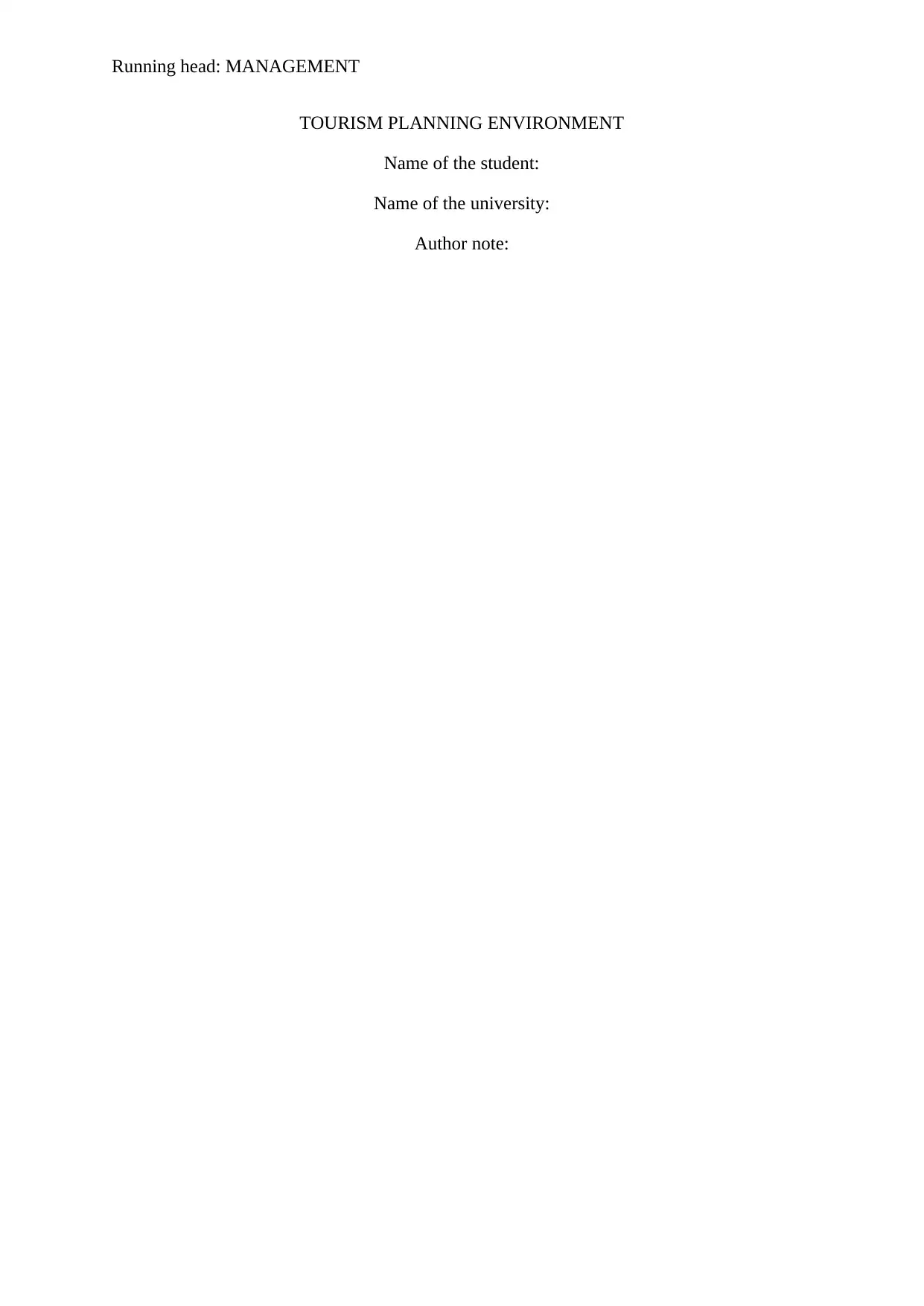
Running head: MANAGEMENT
TOURISM PLANNING ENVIRONMENT
Name of the student:
Name of the university:
Author note:
TOURISM PLANNING ENVIRONMENT
Name of the student:
Name of the university:
Author note:
Paraphrase This Document
Need a fresh take? Get an instant paraphrase of this document with our AI Paraphraser
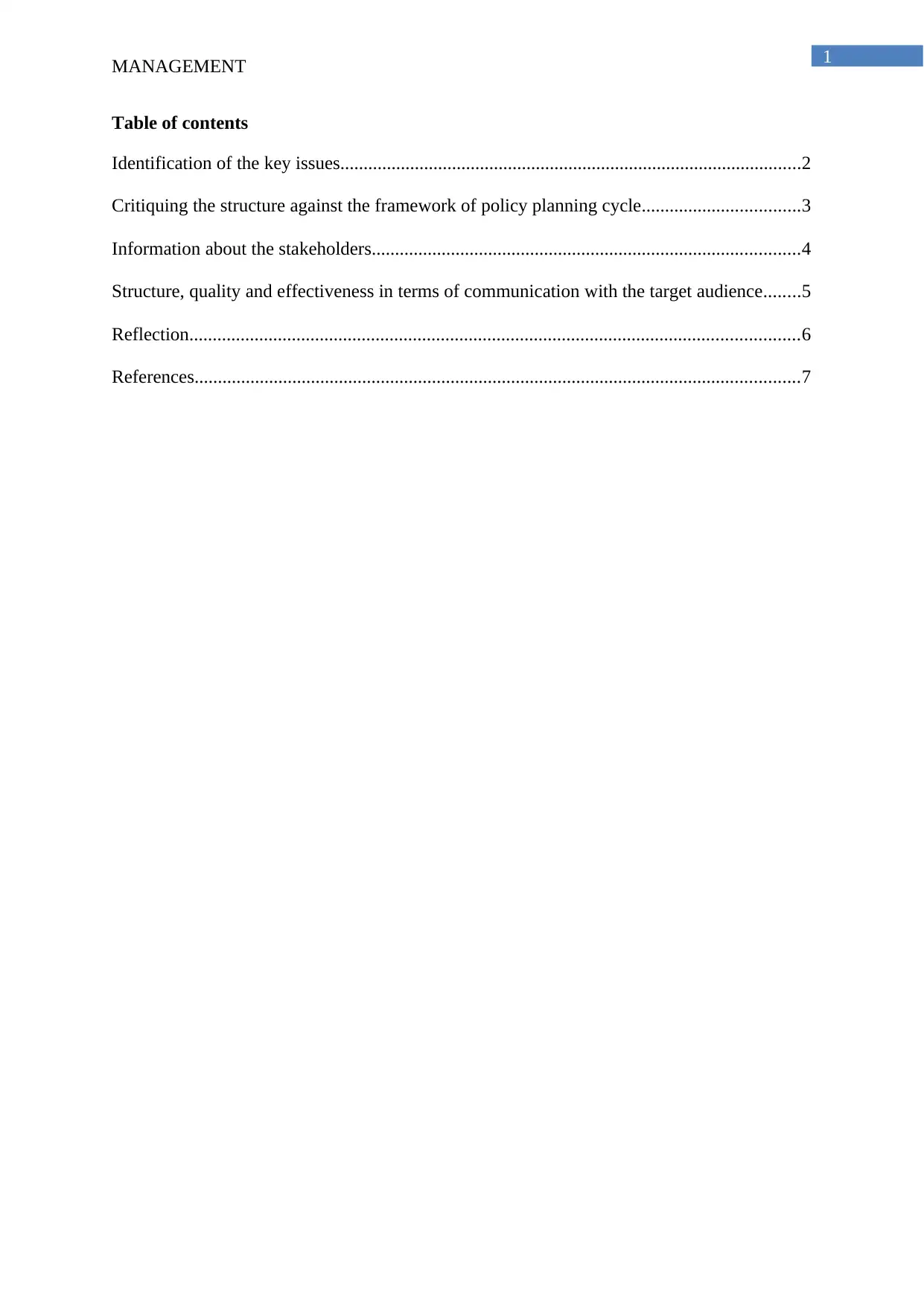
1
MANAGEMENT
Table of contents
Identification of the key issues...................................................................................................2
Critiquing the structure against the framework of policy planning cycle..................................3
Information about the stakeholders............................................................................................4
Structure, quality and effectiveness in terms of communication with the target audience........5
Reflection...................................................................................................................................6
References..................................................................................................................................7
MANAGEMENT
Table of contents
Identification of the key issues...................................................................................................2
Critiquing the structure against the framework of policy planning cycle..................................3
Information about the stakeholders............................................................................................4
Structure, quality and effectiveness in terms of communication with the target audience........5
Reflection...................................................................................................................................6
References..................................................................................................................................7
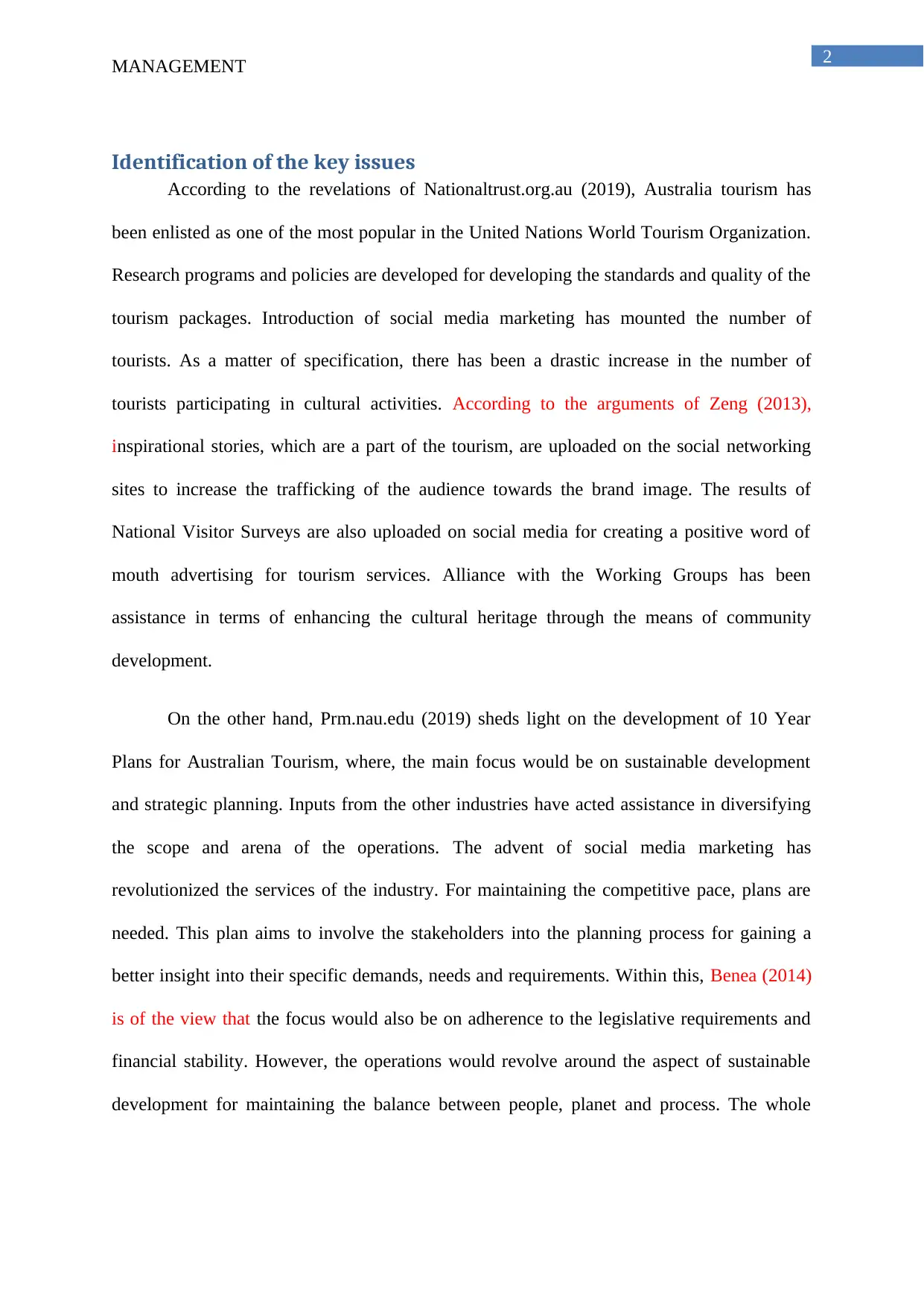
2
MANAGEMENT
Identification of the key issues
According to the revelations of Nationaltrust.org.au (2019), Australia tourism has
been enlisted as one of the most popular in the United Nations World Tourism Organization.
Research programs and policies are developed for developing the standards and quality of the
tourism packages. Introduction of social media marketing has mounted the number of
tourists. As a matter of specification, there has been a drastic increase in the number of
tourists participating in cultural activities. According to the arguments of Zeng (2013),
inspirational stories, which are a part of the tourism, are uploaded on the social networking
sites to increase the trafficking of the audience towards the brand image. The results of
National Visitor Surveys are also uploaded on social media for creating a positive word of
mouth advertising for tourism services. Alliance with the Working Groups has been
assistance in terms of enhancing the cultural heritage through the means of community
development.
On the other hand, Prm.nau.edu (2019) sheds light on the development of 10 Year
Plans for Australian Tourism, where, the main focus would be on sustainable development
and strategic planning. Inputs from the other industries have acted assistance in diversifying
the scope and arena of the operations. The advent of social media marketing has
revolutionized the services of the industry. For maintaining the competitive pace, plans are
needed. This plan aims to involve the stakeholders into the planning process for gaining a
better insight into their specific demands, needs and requirements. Within this, Benea (2014)
is of the view that the focus would also be on adherence to the legislative requirements and
financial stability. However, the operations would revolve around the aspect of sustainable
development for maintaining the balance between people, planet and process. The whole
MANAGEMENT
Identification of the key issues
According to the revelations of Nationaltrust.org.au (2019), Australia tourism has
been enlisted as one of the most popular in the United Nations World Tourism Organization.
Research programs and policies are developed for developing the standards and quality of the
tourism packages. Introduction of social media marketing has mounted the number of
tourists. As a matter of specification, there has been a drastic increase in the number of
tourists participating in cultural activities. According to the arguments of Zeng (2013),
inspirational stories, which are a part of the tourism, are uploaded on the social networking
sites to increase the trafficking of the audience towards the brand image. The results of
National Visitor Surveys are also uploaded on social media for creating a positive word of
mouth advertising for tourism services. Alliance with the Working Groups has been
assistance in terms of enhancing the cultural heritage through the means of community
development.
On the other hand, Prm.nau.edu (2019) sheds light on the development of 10 Year
Plans for Australian Tourism, where, the main focus would be on sustainable development
and strategic planning. Inputs from the other industries have acted assistance in diversifying
the scope and arena of the operations. The advent of social media marketing has
revolutionized the services of the industry. For maintaining the competitive pace, plans are
needed. This plan aims to involve the stakeholders into the planning process for gaining a
better insight into their specific demands, needs and requirements. Within this, Benea (2014)
is of the view that the focus would also be on adherence to the legislative requirements and
financial stability. However, the operations would revolve around the aspect of sustainable
development for maintaining the balance between people, planet and process. The whole
⊘ This is a preview!⊘
Do you want full access?
Subscribe today to unlock all pages.

Trusted by 1+ million students worldwide
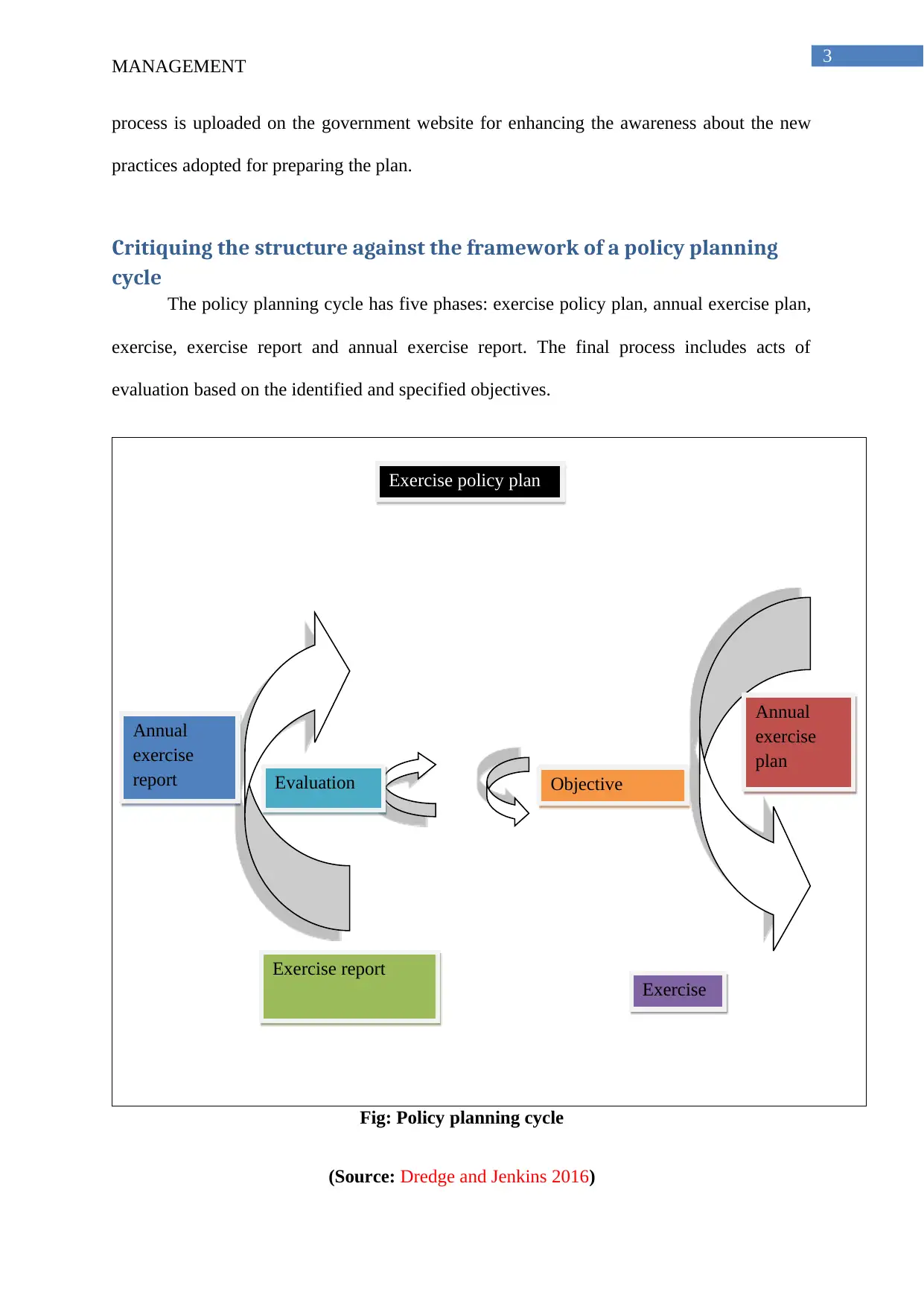
3
MANAGEMENT
process is uploaded on the government website for enhancing the awareness about the new
practices adopted for preparing the plan.
Critiquing the structure against the framework of a policy planning
cycle
The policy planning cycle has five phases: exercise policy plan, annual exercise plan,
exercise, exercise report and annual exercise report. The final process includes acts of
evaluation based on the identified and specified objectives.
Fig: Policy planning cycle
(Source: Dredge and Jenkins 2016)
Exercise policy plan
Annual
exercise
plan
Exercise
Exercise report
Annual
exercise
report Evaluation Objective
MANAGEMENT
process is uploaded on the government website for enhancing the awareness about the new
practices adopted for preparing the plan.
Critiquing the structure against the framework of a policy planning
cycle
The policy planning cycle has five phases: exercise policy plan, annual exercise plan,
exercise, exercise report and annual exercise report. The final process includes acts of
evaluation based on the identified and specified objectives.
Fig: Policy planning cycle
(Source: Dredge and Jenkins 2016)
Exercise policy plan
Annual
exercise
plan
Exercise
Exercise report
Annual
exercise
report Evaluation Objective
Paraphrase This Document
Need a fresh take? Get an instant paraphrase of this document with our AI Paraphraser
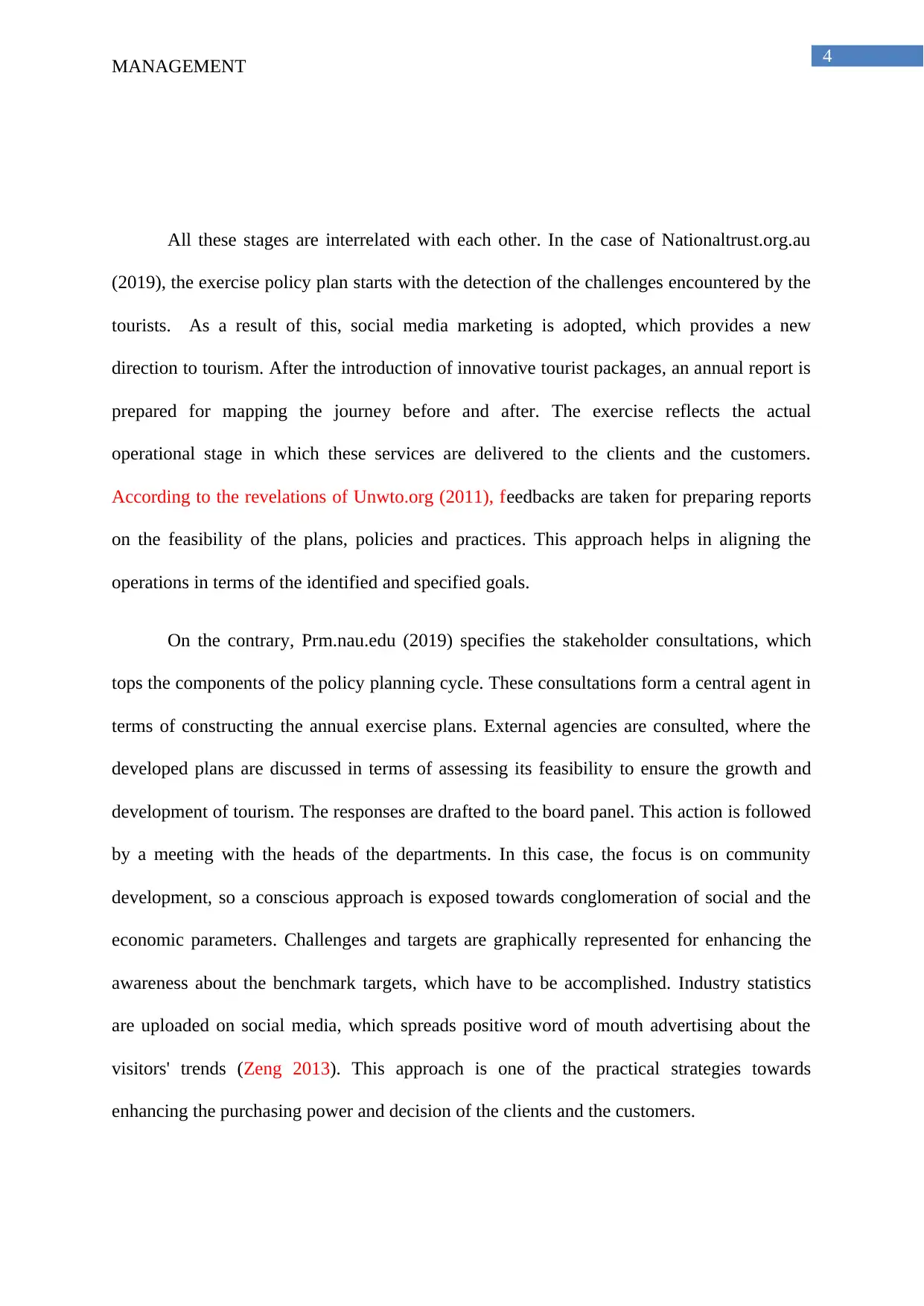
4
MANAGEMENT
All these stages are interrelated with each other. In the case of Nationaltrust.org.au
(2019), the exercise policy plan starts with the detection of the challenges encountered by the
tourists. As a result of this, social media marketing is adopted, which provides a new
direction to tourism. After the introduction of innovative tourist packages, an annual report is
prepared for mapping the journey before and after. The exercise reflects the actual
operational stage in which these services are delivered to the clients and the customers.
According to the revelations of Unwto.org (2011), feedbacks are taken for preparing reports
on the feasibility of the plans, policies and practices. This approach helps in aligning the
operations in terms of the identified and specified goals.
On the contrary, Prm.nau.edu (2019) specifies the stakeholder consultations, which
tops the components of the policy planning cycle. These consultations form a central agent in
terms of constructing the annual exercise plans. External agencies are consulted, where the
developed plans are discussed in terms of assessing its feasibility to ensure the growth and
development of tourism. The responses are drafted to the board panel. This action is followed
by a meeting with the heads of the departments. In this case, the focus is on community
development, so a conscious approach is exposed towards conglomeration of social and the
economic parameters. Challenges and targets are graphically represented for enhancing the
awareness about the benchmark targets, which have to be accomplished. Industry statistics
are uploaded on social media, which spreads positive word of mouth advertising about the
visitors' trends (Zeng 2013). This approach is one of the practical strategies towards
enhancing the purchasing power and decision of the clients and the customers.
MANAGEMENT
All these stages are interrelated with each other. In the case of Nationaltrust.org.au
(2019), the exercise policy plan starts with the detection of the challenges encountered by the
tourists. As a result of this, social media marketing is adopted, which provides a new
direction to tourism. After the introduction of innovative tourist packages, an annual report is
prepared for mapping the journey before and after. The exercise reflects the actual
operational stage in which these services are delivered to the clients and the customers.
According to the revelations of Unwto.org (2011), feedbacks are taken for preparing reports
on the feasibility of the plans, policies and practices. This approach helps in aligning the
operations in terms of the identified and specified goals.
On the contrary, Prm.nau.edu (2019) specifies the stakeholder consultations, which
tops the components of the policy planning cycle. These consultations form a central agent in
terms of constructing the annual exercise plans. External agencies are consulted, where the
developed plans are discussed in terms of assessing its feasibility to ensure the growth and
development of tourism. The responses are drafted to the board panel. This action is followed
by a meeting with the heads of the departments. In this case, the focus is on community
development, so a conscious approach is exposed towards conglomeration of social and the
economic parameters. Challenges and targets are graphically represented for enhancing the
awareness about the benchmark targets, which have to be accomplished. Industry statistics
are uploaded on social media, which spreads positive word of mouth advertising about the
visitors' trends (Zeng 2013). This approach is one of the practical strategies towards
enhancing the purchasing power and decision of the clients and the customers.
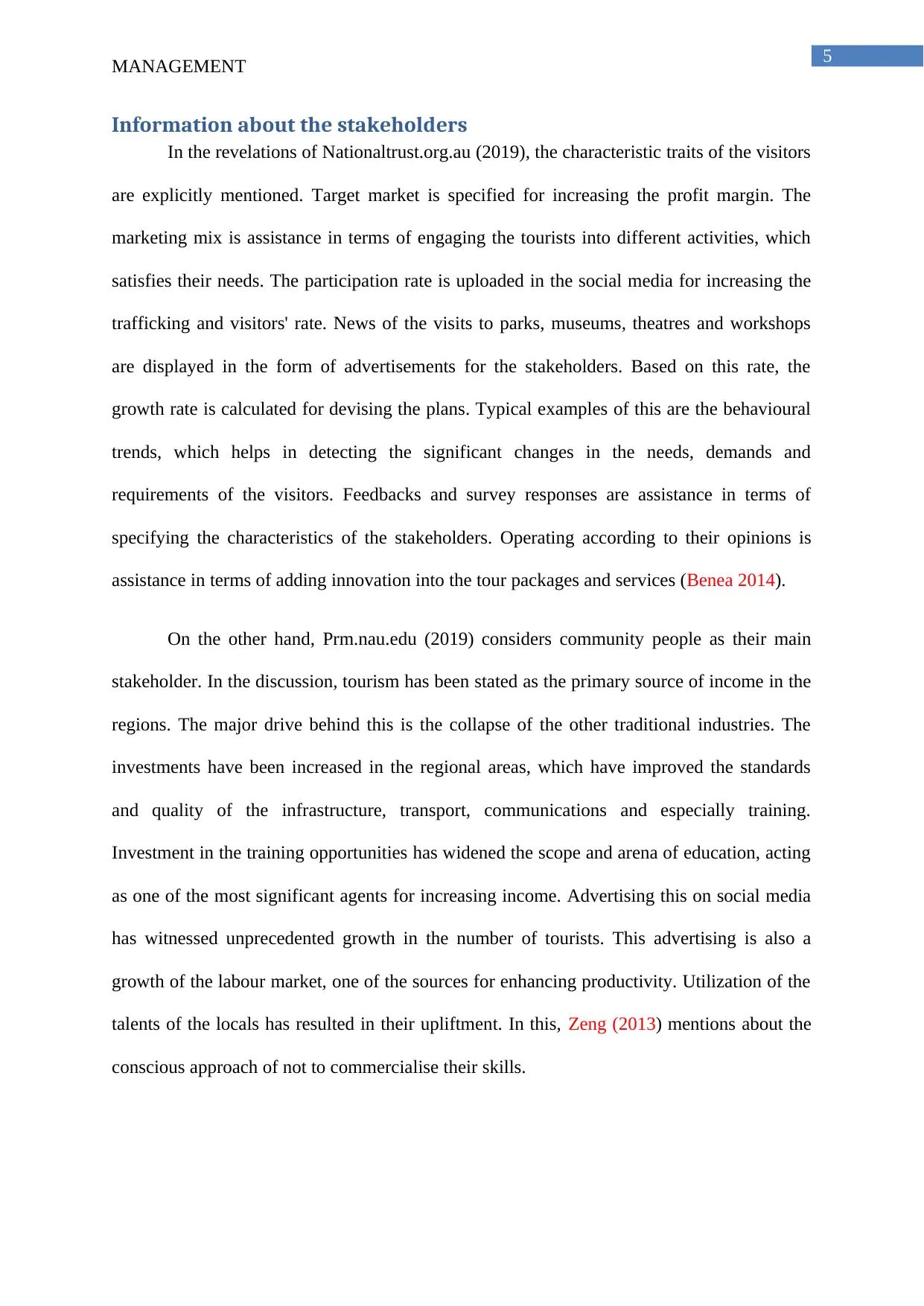
5
MANAGEMENT
Information about the stakeholders
In the revelations of Nationaltrust.org.au (2019), the characteristic traits of the visitors
are explicitly mentioned. Target market is specified for increasing the profit margin. The
marketing mix is assistance in terms of engaging the tourists into different activities, which
satisfies their needs. The participation rate is uploaded in the social media for increasing the
trafficking and visitors' rate. News of the visits to parks, museums, theatres and workshops
are displayed in the form of advertisements for the stakeholders. Based on this rate, the
growth rate is calculated for devising the plans. Typical examples of this are the behavioural
trends, which helps in detecting the significant changes in the needs, demands and
requirements of the visitors. Feedbacks and survey responses are assistance in terms of
specifying the characteristics of the stakeholders. Operating according to their opinions is
assistance in terms of adding innovation into the tour packages and services (Benea 2014).
On the other hand, Prm.nau.edu (2019) considers community people as their main
stakeholder. In the discussion, tourism has been stated as the primary source of income in the
regions. The major drive behind this is the collapse of the other traditional industries. The
investments have been increased in the regional areas, which have improved the standards
and quality of the infrastructure, transport, communications and especially training.
Investment in the training opportunities has widened the scope and arena of education, acting
as one of the most significant agents for increasing income. Advertising this on social media
has witnessed unprecedented growth in the number of tourists. This advertising is also a
growth of the labour market, one of the sources for enhancing productivity. Utilization of the
talents of the locals has resulted in their upliftment. In this, Zeng (2013) mentions about the
conscious approach of not to commercialise their skills.
MANAGEMENT
Information about the stakeholders
In the revelations of Nationaltrust.org.au (2019), the characteristic traits of the visitors
are explicitly mentioned. Target market is specified for increasing the profit margin. The
marketing mix is assistance in terms of engaging the tourists into different activities, which
satisfies their needs. The participation rate is uploaded in the social media for increasing the
trafficking and visitors' rate. News of the visits to parks, museums, theatres and workshops
are displayed in the form of advertisements for the stakeholders. Based on this rate, the
growth rate is calculated for devising the plans. Typical examples of this are the behavioural
trends, which helps in detecting the significant changes in the needs, demands and
requirements of the visitors. Feedbacks and survey responses are assistance in terms of
specifying the characteristics of the stakeholders. Operating according to their opinions is
assistance in terms of adding innovation into the tour packages and services (Benea 2014).
On the other hand, Prm.nau.edu (2019) considers community people as their main
stakeholder. In the discussion, tourism has been stated as the primary source of income in the
regions. The major drive behind this is the collapse of the other traditional industries. The
investments have been increased in the regional areas, which have improved the standards
and quality of the infrastructure, transport, communications and especially training.
Investment in the training opportunities has widened the scope and arena of education, acting
as one of the most significant agents for increasing income. Advertising this on social media
has witnessed unprecedented growth in the number of tourists. This advertising is also a
growth of the labour market, one of the sources for enhancing productivity. Utilization of the
talents of the locals has resulted in their upliftment. In this, Zeng (2013) mentions about the
conscious approach of not to commercialise their skills.
⊘ This is a preview!⊘
Do you want full access?
Subscribe today to unlock all pages.

Trusted by 1+ million students worldwide
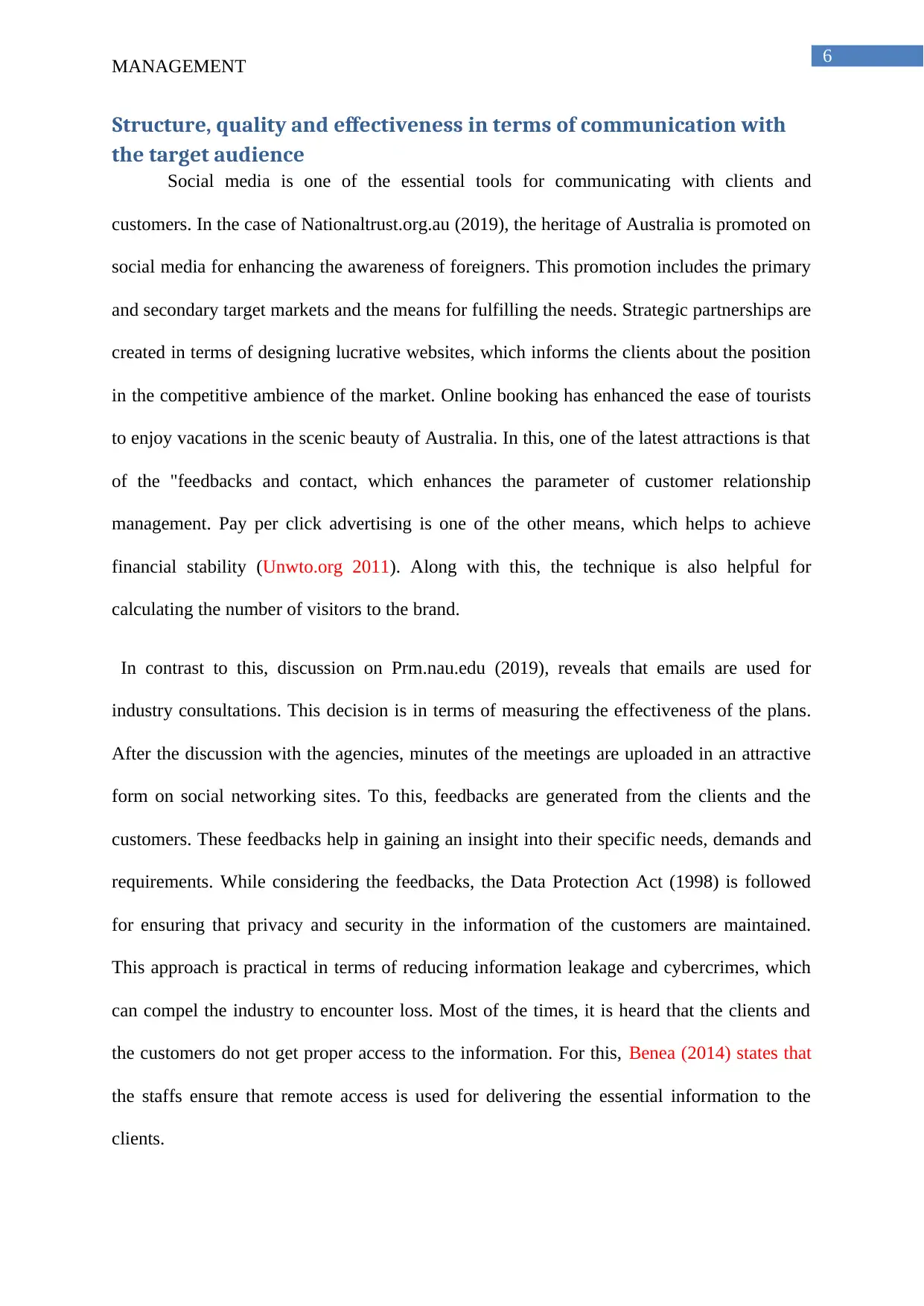
6
MANAGEMENT
Structure, quality and effectiveness in terms of communication with
the target audience
Social media is one of the essential tools for communicating with clients and
customers. In the case of Nationaltrust.org.au (2019), the heritage of Australia is promoted on
social media for enhancing the awareness of foreigners. This promotion includes the primary
and secondary target markets and the means for fulfilling the needs. Strategic partnerships are
created in terms of designing lucrative websites, which informs the clients about the position
in the competitive ambience of the market. Online booking has enhanced the ease of tourists
to enjoy vacations in the scenic beauty of Australia. In this, one of the latest attractions is that
of the "feedbacks and contact, which enhances the parameter of customer relationship
management. Pay per click advertising is one of the other means, which helps to achieve
financial stability (Unwto.org 2011). Along with this, the technique is also helpful for
calculating the number of visitors to the brand.
In contrast to this, discussion on Prm.nau.edu (2019), reveals that emails are used for
industry consultations. This decision is in terms of measuring the effectiveness of the plans.
After the discussion with the agencies, minutes of the meetings are uploaded in an attractive
form on social networking sites. To this, feedbacks are generated from the clients and the
customers. These feedbacks help in gaining an insight into their specific needs, demands and
requirements. While considering the feedbacks, the Data Protection Act (1998) is followed
for ensuring that privacy and security in the information of the customers are maintained.
This approach is practical in terms of reducing information leakage and cybercrimes, which
can compel the industry to encounter loss. Most of the times, it is heard that the clients and
the customers do not get proper access to the information. For this, Benea (2014) states that
the staffs ensure that remote access is used for delivering the essential information to the
clients.
MANAGEMENT
Structure, quality and effectiveness in terms of communication with
the target audience
Social media is one of the essential tools for communicating with clients and
customers. In the case of Nationaltrust.org.au (2019), the heritage of Australia is promoted on
social media for enhancing the awareness of foreigners. This promotion includes the primary
and secondary target markets and the means for fulfilling the needs. Strategic partnerships are
created in terms of designing lucrative websites, which informs the clients about the position
in the competitive ambience of the market. Online booking has enhanced the ease of tourists
to enjoy vacations in the scenic beauty of Australia. In this, one of the latest attractions is that
of the "feedbacks and contact, which enhances the parameter of customer relationship
management. Pay per click advertising is one of the other means, which helps to achieve
financial stability (Unwto.org 2011). Along with this, the technique is also helpful for
calculating the number of visitors to the brand.
In contrast to this, discussion on Prm.nau.edu (2019), reveals that emails are used for
industry consultations. This decision is in terms of measuring the effectiveness of the plans.
After the discussion with the agencies, minutes of the meetings are uploaded in an attractive
form on social networking sites. To this, feedbacks are generated from the clients and the
customers. These feedbacks help in gaining an insight into their specific needs, demands and
requirements. While considering the feedbacks, the Data Protection Act (1998) is followed
for ensuring that privacy and security in the information of the customers are maintained.
This approach is practical in terms of reducing information leakage and cybercrimes, which
can compel the industry to encounter loss. Most of the times, it is heard that the clients and
the customers do not get proper access to the information. For this, Benea (2014) states that
the staffs ensure that remote access is used for delivering the essential information to the
clients.
Paraphrase This Document
Need a fresh take? Get an instant paraphrase of this document with our AI Paraphraser
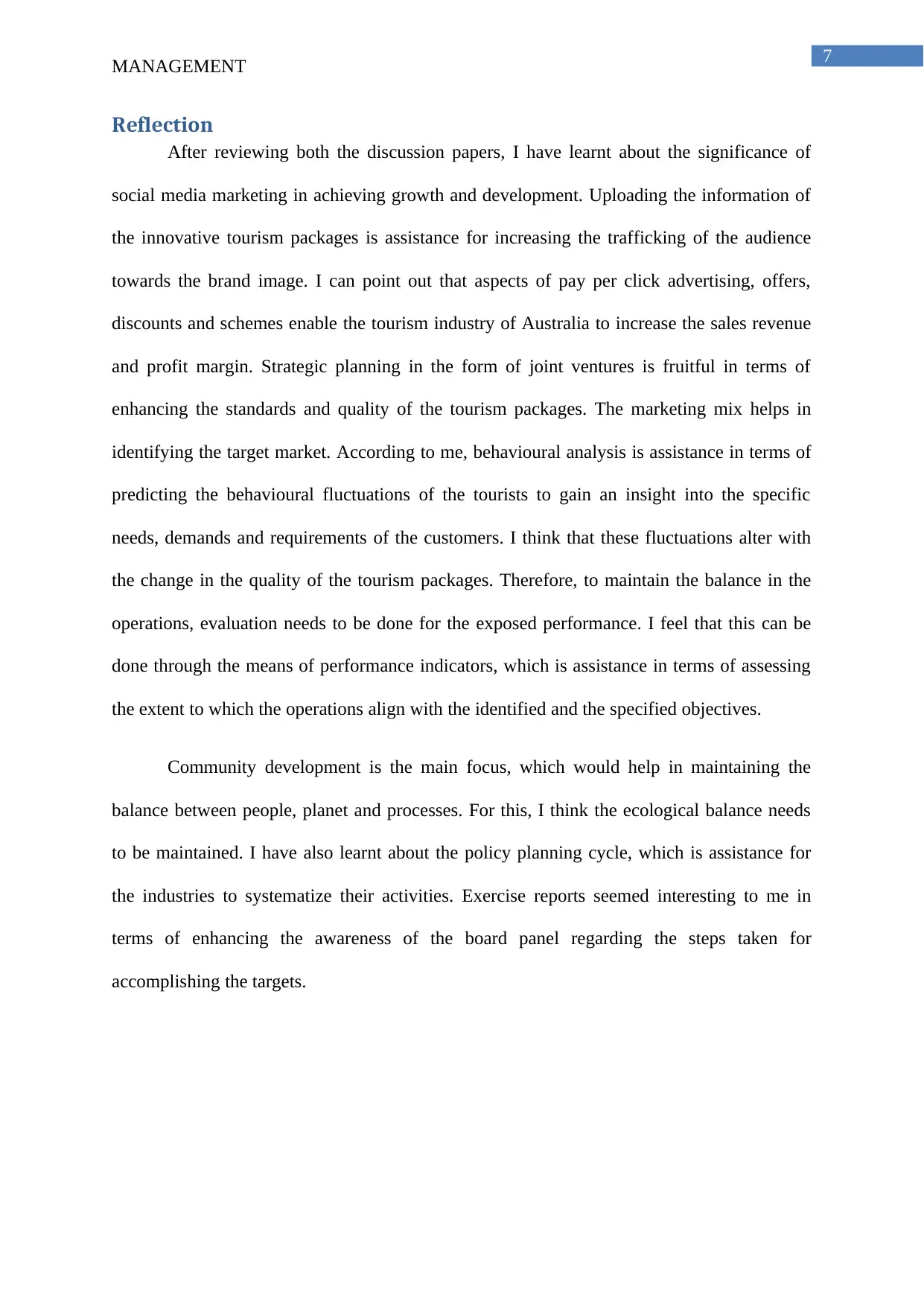
7
MANAGEMENT
Reflection
After reviewing both the discussion papers, I have learnt about the significance of
social media marketing in achieving growth and development. Uploading the information of
the innovative tourism packages is assistance for increasing the trafficking of the audience
towards the brand image. I can point out that aspects of pay per click advertising, offers,
discounts and schemes enable the tourism industry of Australia to increase the sales revenue
and profit margin. Strategic planning in the form of joint ventures is fruitful in terms of
enhancing the standards and quality of the tourism packages. The marketing mix helps in
identifying the target market. According to me, behavioural analysis is assistance in terms of
predicting the behavioural fluctuations of the tourists to gain an insight into the specific
needs, demands and requirements of the customers. I think that these fluctuations alter with
the change in the quality of the tourism packages. Therefore, to maintain the balance in the
operations, evaluation needs to be done for the exposed performance. I feel that this can be
done through the means of performance indicators, which is assistance in terms of assessing
the extent to which the operations align with the identified and the specified objectives.
Community development is the main focus, which would help in maintaining the
balance between people, planet and processes. For this, I think the ecological balance needs
to be maintained. I have also learnt about the policy planning cycle, which is assistance for
the industries to systematize their activities. Exercise reports seemed interesting to me in
terms of enhancing the awareness of the board panel regarding the steps taken for
accomplishing the targets.
MANAGEMENT
Reflection
After reviewing both the discussion papers, I have learnt about the significance of
social media marketing in achieving growth and development. Uploading the information of
the innovative tourism packages is assistance for increasing the trafficking of the audience
towards the brand image. I can point out that aspects of pay per click advertising, offers,
discounts and schemes enable the tourism industry of Australia to increase the sales revenue
and profit margin. Strategic planning in the form of joint ventures is fruitful in terms of
enhancing the standards and quality of the tourism packages. The marketing mix helps in
identifying the target market. According to me, behavioural analysis is assistance in terms of
predicting the behavioural fluctuations of the tourists to gain an insight into the specific
needs, demands and requirements of the customers. I think that these fluctuations alter with
the change in the quality of the tourism packages. Therefore, to maintain the balance in the
operations, evaluation needs to be done for the exposed performance. I feel that this can be
done through the means of performance indicators, which is assistance in terms of assessing
the extent to which the operations align with the identified and the specified objectives.
Community development is the main focus, which would help in maintaining the
balance between people, planet and processes. For this, I think the ecological balance needs
to be maintained. I have also learnt about the policy planning cycle, which is assistance for
the industries to systematize their activities. Exercise reports seemed interesting to me in
terms of enhancing the awareness of the board panel regarding the steps taken for
accomplishing the targets.
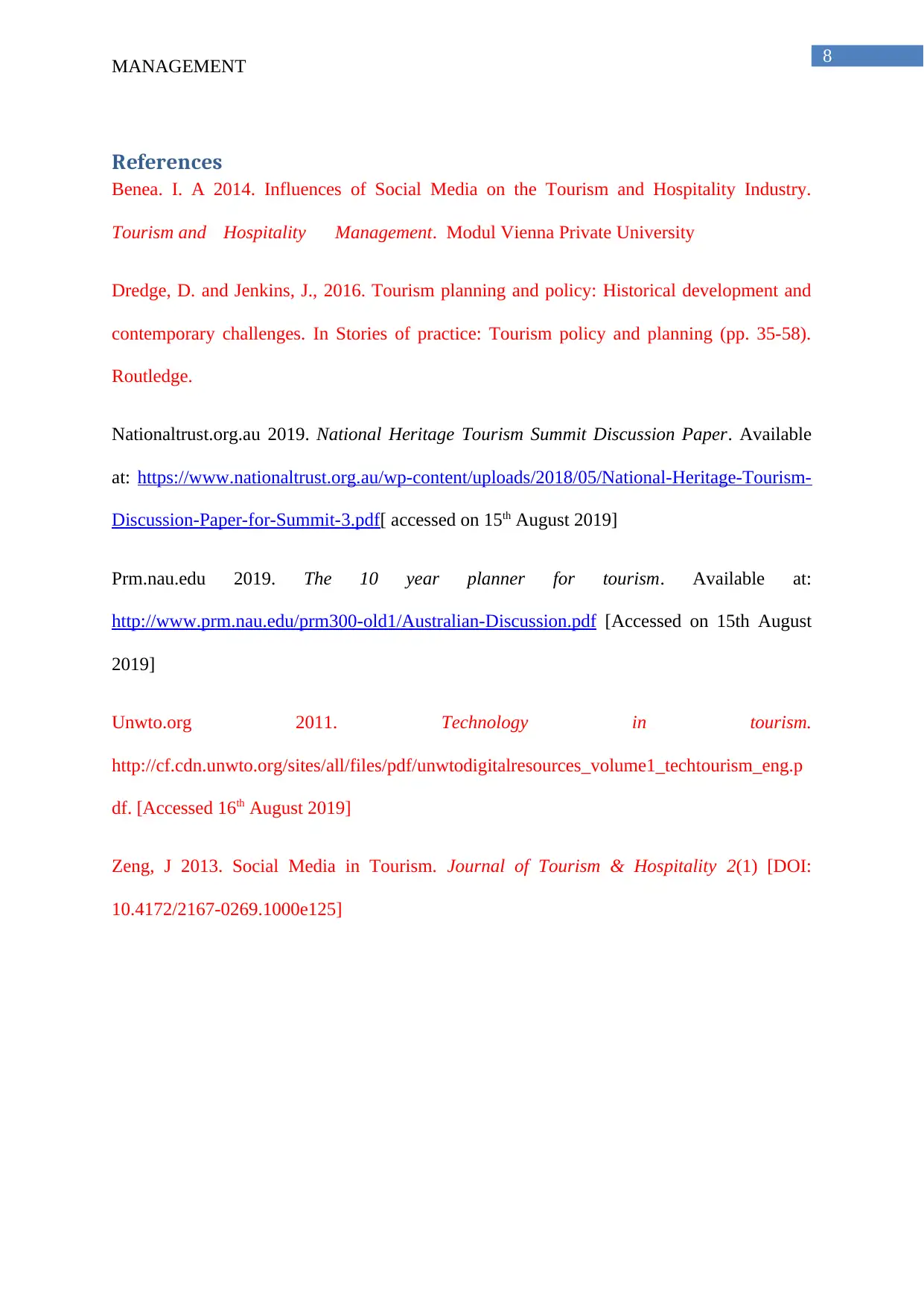
8
MANAGEMENT
References
Benea. I. A 2014. Influences of Social Media on the Tourism and Hospitality Industry.
Tourism and Hospitality Management. Modul Vienna Private University
Dredge, D. and Jenkins, J., 2016. Tourism planning and policy: Historical development and
contemporary challenges. In Stories of practice: Tourism policy and planning (pp. 35-58).
Routledge.
Nationaltrust.org.au 2019. National Heritage Tourism Summit Discussion Paper. Available
at: https://www.nationaltrust.org.au/wp-content/uploads/2018/05/National-Heritage-Tourism-
Discussion-Paper-for-Summit-3.pdf[ accessed on 15th August 2019]
Prm.nau.edu 2019. The 10 year planner for tourism. Available at:
http://www.prm.nau.edu/prm300-old1/Australian-Discussion.pdf [Accessed on 15th August
2019]
Unwto.org 2011. Technology in tourism.
http://cf.cdn.unwto.org/sites/all/files/pdf/unwtodigitalresources_volume1_techtourism_eng.p
df. [Accessed 16th August 2019]
Zeng, J 2013. Social Media in Tourism. Journal of Tourism & Hospitality 2(1) [DOI:
10.4172/2167-0269.1000e125]
MANAGEMENT
References
Benea. I. A 2014. Influences of Social Media on the Tourism and Hospitality Industry.
Tourism and Hospitality Management. Modul Vienna Private University
Dredge, D. and Jenkins, J., 2016. Tourism planning and policy: Historical development and
contemporary challenges. In Stories of practice: Tourism policy and planning (pp. 35-58).
Routledge.
Nationaltrust.org.au 2019. National Heritage Tourism Summit Discussion Paper. Available
at: https://www.nationaltrust.org.au/wp-content/uploads/2018/05/National-Heritage-Tourism-
Discussion-Paper-for-Summit-3.pdf[ accessed on 15th August 2019]
Prm.nau.edu 2019. The 10 year planner for tourism. Available at:
http://www.prm.nau.edu/prm300-old1/Australian-Discussion.pdf [Accessed on 15th August
2019]
Unwto.org 2011. Technology in tourism.
http://cf.cdn.unwto.org/sites/all/files/pdf/unwtodigitalresources_volume1_techtourism_eng.p
df. [Accessed 16th August 2019]
Zeng, J 2013. Social Media in Tourism. Journal of Tourism & Hospitality 2(1) [DOI:
10.4172/2167-0269.1000e125]
⊘ This is a preview!⊘
Do you want full access?
Subscribe today to unlock all pages.

Trusted by 1+ million students worldwide
1 out of 9
Related Documents
Your All-in-One AI-Powered Toolkit for Academic Success.
+13062052269
info@desklib.com
Available 24*7 on WhatsApp / Email
![[object Object]](/_next/static/media/star-bottom.7253800d.svg)
Unlock your academic potential
Copyright © 2020–2025 A2Z Services. All Rights Reserved. Developed and managed by ZUCOL.





